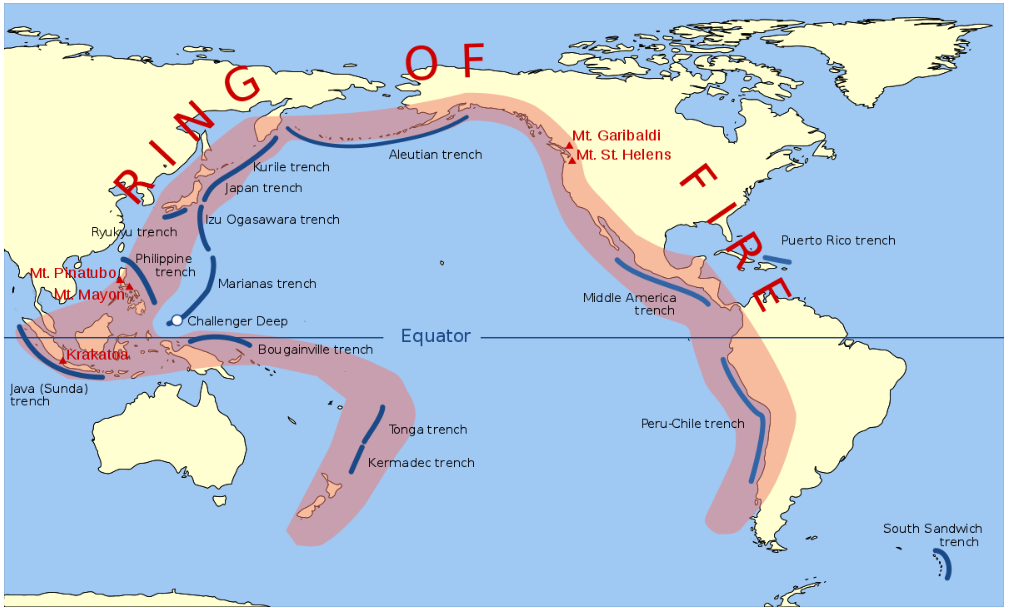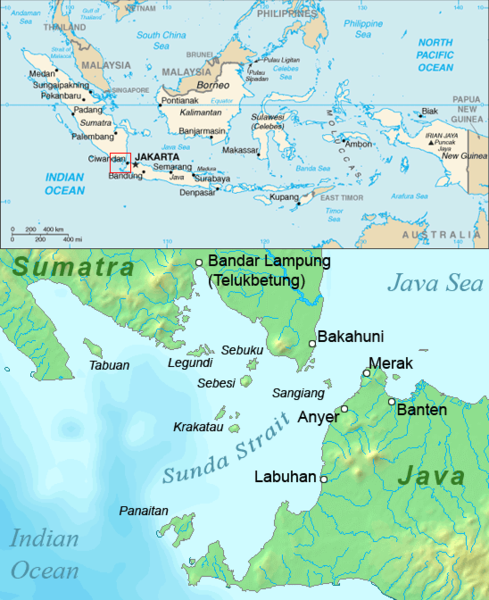

Mount Anak Krakatau volcano eruption update.
December
On Saturday evening, Mount Anak Krakatau, a volcanic island situated between the islands of Java and Samatra in the Sunda Strait in the Indonesia province, erupted, triggering multiple tsunamis without warning when, it was believed at the time, underwater landslides caused by the eruption occurred.
Officials have raised the alert levels to red, and “all flights are rerouted” and “an exclusion zone” has been extended to a 3-mile radius as ash continues to spew from the volcano, NPR reported yesterday.
As a result of the eruption, it has now been determined that the multiple tsunamis that were triggered causing “waves more than 6 1/2 feet high to crash into coastlines along the Sunda Strait” were due to a collapse of “a section of the volcano’s crater.”
On Saturday evening, officials said that Anak Krakatau volcano had been active since June and that while tsunamis caused by a volcanic eruption are rare, “as long as there is increased activity” more tsunamis were possible.
Now the Indonesian government is “cautioning nearby communities to stay at least 1 kilometer away from the coastline.”
“Since December 23, activity has not stopped … We anticipate a further escalation,” said Antonius Ratdomopurbo, secretary of the geological agency, according to Reuters.
NPR

The death toll has risen to almost 430 and 159 are still missing. According to a Reuter’s report, via NPR, “nearly 20,000 people have been displaced … and nearly 1,500 injured.”
September
This is the second time this region has been hit by tsunami waves in the past three months.
On Friday, September 28, as TNB reported, a 7.5 magnitude earthquake struck in the Indonesia province off the island of Sulawesi, “along the coastal district of Donggala.” The quake triggered deadly tsunamis along the coast and up into the bay of Palu into the city of Palu, “causing at least 1,400 deaths, injuring 2,500 others and displacing tens of thousands more.”
As of a week after the disaster, those hit hardest were still yet to be fully assessed and officials at the time estimated that “up to 1.6 million people may have been affected.” Aftershocks, some registering 6.0, hit the island of Sumba on that following Monday – an island which is located “hundreds of miles away from Sulawesi.”
The coast was hit by two waves, one, some have reported, was almost 18 feet high, with no warning.
Although Indonesia is chronically at risk of tsunamis, Andri Manganti, a resident of Palu who lost his home in Friday’s earthquake, said that no warning siren sounded before the wave — estimated to be a towering 18 feet high — struck the city of about 300,000 people.
Text messages that were supposed to warn locals of the possibility of a tsunami did not go out as planned because cellphone towers had been downed by the earthquake, Mr. Sutopo said.
Indonesia’s meteorological and geophysics agency is facing criticism for having lifted its tsunami warning little more than half an hour after the earthquake struck. It is not yet certain whether the devastating wave that was described by Mr. Sutopo as around 18 feet in height struck before or after the tsunami warning was lifted.
New York Times; Sept 29 2018
Translation: “The seconds when the tsunami hit Palu Beach on 9/28/2018 afternoon after the 7.7 magnitude earthquake shook Donggala. The tsunami height is around 3 meters. The settlements around the coast were destroyed by the tsunami.”
In addition to the earthquake and tsunami, a volcano on Sulawesi — Mount Soputan — erupted on Wednesday, spewing ash nearly 20,000 feet into the sky, according to The Associated Press. The AP reports that a government volcanologist believes the eruption and earthquake could be connected. Volcanic activity had been increasing since August and reportedly ramped up starting Monday.
NPR; Oct 2 2018
August
On August 5th, a 7.0 earthquake hit the island of Lombok, Indonesia, struck, claiming “at least 98 lives and injured an additional 236 people,” sending tourists fleeing and leaving at least 20,000 residents displaced, the New York Times reported.
The quake ended up claiming the lives of “at least 460 people, injured more than a thousand others,” according to an NPR report.
Less than a month later, on August 16, a series of three earthquakes hit the same island of Lombok, the strongest a 6.9 which followed two earlier ones in the day that “registered at magnitudes 6.3 and 5.4 respectively,” NPR reported via the Associated Press.
“Another 6.4-magnitude earthquake on July 29 killed at least 16 and injured more than 100 others.”
